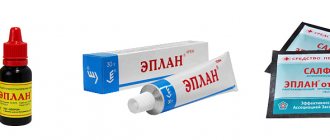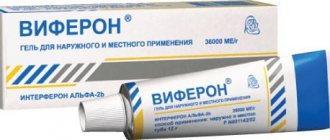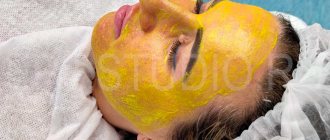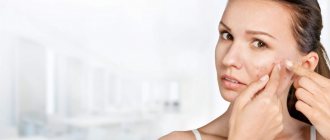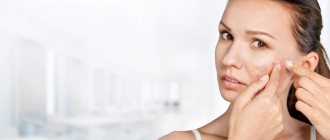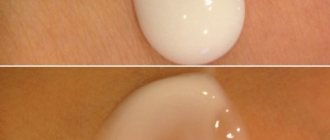Anti-inflammatory drug. Application: dermatitis, seborrhea, acne. Price from 375 rub.
Analogs: Retinoic ointment, Isotrexin, Roaccutane, Dermoretin. You can find out more about analogues, their prices, and whether they are substitutes at the end of this article.
Today we’ll talk about Retasol ointment. What is this product and how does it affect the body? What are the indications and contraindications? How and in what doses is it used? What can be replaced?
What kind of ointment
Retasol is used to get rid of acne and other cosmetic skin defects.
The ointment and solution contain instructions for use, which contain a detailed description of the composition of the medicinal product. Its pharmacological properties, list of indications and prohibitions for use.
In addition to treating acne, Retasol is used for peeling - cleanses the skin of dead and keratinized particles, exfoliates the rough surface layer.
The drug is also used to combat seborrhea. It stops the development of the disease process and promotes self-healing of the skin.
Pharmacodynamics and pharmacokinetics
Retinoic acid stops the pathological proliferation of sebaceous duct tissue. As a result, sebum production slows down; prevents the appearance of dead and keratinized particles, microcomedones (horny plugs).
It has an anti-inflammatory effect at the site of purulent lesions, awakens the body's defenses at the site of application.
Isotretinoin accelerates collagen synthesis and restores deep skin layers, wrinkles are smoothed out, and skin elasticity is restored.
The active substance is practically not absorbed into the systemic bloodstream and does not produce a systematic effect on internal organs.
Long-term use is not addictive, the therapeutic effect lasts up to four months after use.
Removal of decay products occurs through the kidneys and intestines.
Side effects
At the beginning of treatment, Retasol may cause redness and excessive peeling of the skin.
After getting used to retinoic acid, these phenomena go away on their own, without special treatment.
If skin irritation persists after two to four days, stop using the drug.
Other negative reactions are also possible. Thinning of the skin, dry skin, itching, burning, increased granulation of the affected area, increased sweating, peeling and dryness of the palms and soles, erythema, contact dermatitis.
Very rarely, sensitivity to light increases.
special instructions
Do not use the product if you have allergic reactions or severe inflammation of the affected area of the skin. Do not apply to the skin in the eye area.
If Retasol is used in combination with other drugs, make sure that they do not contain ethyl alcohol - its excess dries out the skin.
Additional use of drugs with vitamin A may lead to hypervitaminosis.
The presence of concentrated vitamin A increases the photosensitivity of the skin - exposure to open sunlight is not recommended.
Retasol reduces the effectiveness of hormonal contraceptives. Do not use simultaneously with tetracyclines for the prevention of increased intracranial pressure.
The simultaneous use of glucocorticosteroids weakens the effect of Retasol.
Vitamin A or retinol
Currently, the beauty industry offers a wide range of different products for women. Among them, products containing retinol stand out. Is this substance only necessary for those who want to look good?
What is vitamin A and where does Retinol come from?
Vitamin A was first obtained in the 50s of the 20th century. From the very first lines it must be said that vitamin A and Retinol are one and the same substance. Beta-carotene, which enters the body, is then converted into vitamin A. In the body, as a result of oxidative processes, Retinol is modified through chemical reactions into an aldehyde, which further participates in complex biochemical processes.
Vitamin A has many beneficial functions, including:
- formation of the barrier function of the skin and mucous membranes
- increased permeability of cell membranes
- participation in protein synthesis
- responsible role in the formation of vision at twilight
Sources of retinol
There is a large list of products saturated with this wonderful substance: liver of large horned animals, milk, sour cream, egg yolks, cream, fatty fish meat (cod, halibut, sea bass). The amount of retinol in these products, of course, is different, and also has its own seasonality; in summer the vitamin A content is higher than in winter.
Plant foods also contain retinol, including: tomatoes, carrots, greens, apricots, red peppers.
It is important to note that these products contain carotene, which is a precursor to vitamin A, and its biological activity is approximately 5.5 times less than retinol itself.
What daily requirement is necessary for a full life?
Each of us is individual, and accordingly, the normal amount of retinol varies depending on the body’s needs. The approximate requirement for an adult per day is 1 mg, for pregnant women - 1.25 - 1.55 mg, and for children 0.4 - 1 mg.
Is it possible to increase the dose and make up for the lack of retinol in a few days or stock up in advance?
An interesting trend is observed when consuming substances containing retinol, as well as food. When taking 100,000 IU, absorption in the small intestine is reduced to 10%, and when taking 3,000 IU, 100% of this substance is absorbed. This is due to an increase in oxidative processes, which acts to reduce the likelihood of retinol intoxication.
What symptoms appear with a lack of vitamin A?
With a lack of retinol, symptoms appear gradually, gradually. Among them, doctors identify the following:
- blurred vision at dusk. This disease is popularly called “night blindness.” As a result, a person is unable to navigate in space after dark; this is one of the early warning signs about a problem in the body.
- damage to the cornea, dysfunction of the retina and conjunctiva
- changes in skin elasticity. Dry skin appears. Dermatovenerologists call this disease keratosis pilaris. The epithelium becomes keratinized and the activity of the sweat and sebaceous glands decreases. A rash appears on the thighs, forearms and other parts of the body.
- weight loss and exhaustion of the body
If eye symptoms appear, it is necessary to consult an ophthalmologist and prescribe treatment. At home, it is impossible to clearly determine whether this disease is a consequence of a decrease in the amount of retinol in the body.
What tests does the doctor do?
After collecting complaints, the doctor will prescribe not only laboratory tests, but also conduct a number of studies. What is used:
- determination of retinol content in the blood on an empty stomach and after taking vitamin A
- visual field examination
- biomicroscopy of the cornea
- examination of the skin and visible mucous membranes
- research on adaptation in dark environments
What is needed for skin treatment?
Dermatovenerologists widely use a drug such as Retinol acetate to treat keratosis pilaris. This pharmaceutical drug is prescribed in short courses. When taking it, redness and peeling may occur. This is due to the skin adapting to the new substance.
There are a number of rules for taking this remedy:
- should not be taken if you are going to go outside where there is active sunlight. In this case, taking sunscreen is mandatory because vitamin A is destroyed by ultraviolet light.
- the combination of Retinol acetate and scrub masks is not recommended. As a result, an imbalance occurs between the appearance of the old and new layer of epithelial cells
- The skin needs to get used to this product. You should start by using this drug once a week, gradually reaching 3 times a week.
The course of treatment is at least 2 months with a repeat examination by a dermatovenerologist.
There are many other creams that contain vitamin A. It is important to note that its content must be at least 1% to have a full effect on the skin.
Vitamin A is also contained in 100,000 IU capsules. It is recommended to take 1 capsule per course for the treatment of eye symptoms and as maintenance therapy for local treatment of keratosis pilaris.
In conclusion, it must be said that despite the understandable symptoms, a lack of vitamin A, as the cause of these manifestations, can only be identified by a medical specialist who is able to distinguish this cause from a number of other similar symptoms and diseases.
Literature:
Kalinina O.V. THERAPY OF SEBORRHEIC DERMATITIS OF THE SCALP//Russian Journal of Skin and Venereal Diseases 2014 No. 2
Analogs
Analogs of Retasol are Retinoic ointment, Isotrexin, Roaccutane, Dermoretin. The active ingredient in these medications is retinoic acid, a concentrated form of vitamin A.
- Isotrexin is a combination drug that contains two active components - concentrated vitamin A isotretinoin and the antibiotic erythromycin. Isotrexin has a wider list of indications; it is used in the complex treatment of inflammatory skin diseases of various origins, caused by bacteria and of autoimmune origin - psoriasis, seborrhea, dermatitis. The drug is in the same price category as the drug in question.
- Retinoic ointment - the therapeutic component is retinoic acid (isotretinoin) from the group of retinoids. The ointment is used for the same indications as Retasol, but there is a difference - the fatty base of the ointment is suitable for treating dry skin defects; for oily skin, an alcohol solution of Retasol is more suitable. The price of retinoic ointment is slightly lower than Retasol.
- Roaccutane is a capsule of the drug isotretinoin. The price of Roaccutane is in the range of 2000-4000 rubles, which is 5-10 times more expensive than Retasol.
- Dermoretin - produced in capsules and rectal suppositories for the treatment of severe forms of acne. Dermoretin is currently not available in pharmacies.
- Verocutan is a product in capsules that costs about 700 rubles.
A new domestic drug for the treatment of acne - Retasol
as an advertisement
Retasol ® has proven itself well for the treatment of ACNE.
.
Original domestic drug Retasol ®
is a solution
for external use
containing 0.025% isotretinoin in an alcohol-glycol base.
It belongs to the topical retinoids and is intended for the treatment of mild and moderate forms of acne. The solution is a clear, slightly oily, light yellow liquid. Available in 50 ml dark glass bottles. A small amount of the drug is applied with a cotton swab to previously cleansed dry skin 2 times a day (morning and evening). To cleanse the skin, it is recommended to use liquid cosmetics - foams, washing gels, cosmetic milk, non-alcoholic tonic. It is undesirable (to avoid overdrying) to use solid soap and alcohol-containing solutions to cleanse the skin. Once the effect is achieved, the frequency of application of the drug is reduced. In persons with thin, sensitive skin, at the beginning of treatment it is recommended to use the drug once a day (in the evening). Avoid using the solution on the mucous membranes and eyelid area. The duration of treatment with Retasol ®
is 4–12 weeks.
After 2–3 days of treatment with Retasol ®
Most patients experience an exacerbation reaction, expressed in redness, moderate itching, and peeling of the skin.
There is no need to be afraid, because this is a normal skin reaction to the drug. The exacerbation goes away on its own within a few days, after which persistent improvement occurs. During treatment, dry lips, cracks in the corners of the mouth, and peeling of the skin may appear; These phenomena can be eliminated by using a neutral moisturizing cream for the face and body, hygienic lipstick, and limiting the use of detergents. If pregnancy occurs, treatment with Retasol ®
is discontinued.
use systemic retinoids, ultraviolet irradiation, exfoliating cosmetic procedures and products (scrubs, peeling) simultaneously with Retasol ®
How does Retasol ® work?
Isotretinoin is recognized by dermatologists as a leading treatment for acne*, since it affects all the main stages of acne development. Retasol ®
does not mask the disease, but eliminates its causes:
- reduces the size of sebaceous glands;
- helps reduce sebum production;
- facilitates the secretion of sebum;
- reduces the inflammatory reaction around the sebaceous glands;
- increases the protective functions of the skin;
- enhances skin regeneration.
Retasol®
It is used externally and almost does not enter the bloodstream, which means it does not affect organs and tissues. Acting only in the skin, it has a therapeutic effect, and undesirable effects are mainly local in nature.
At what age can Retasol® be used?
The first acne can appear at the age of 8–13 years, when the oiliness of the skin increases, the first comedones (acne in the form of black dots) appear, and there are few inflammatory rashes at this stage. Retasol® can be used from the age of 11 (according to the instructions).
What skin type is Retasol® suitable for?
Retasol® is ideal for oily skin. By using it, you will not only cure acne, but also get rid of oily sheen.
How to use Retasol® for preventive purposes?
Once a day 2-3 times a week for 3 months at night.
A small amount of the drug is applied with a cotton swab to previously cleansed dry skin, avoiding application to the skin around the eyes, in the corners of the mouth and at the entrance to the nasal cavity.
How to use Retasol® for treatment?
Twice a day (morning and night) for 1–4 months.
The solution is applied after washing to clean, dry skin over the entire affected area, except for areas near the eyes, corners of the mouth and at the entrance to the nasal cavity. Once a good effect is achieved, the frequency of application of the drug is reduced. In people with thin and sensitive skin, at the beginning of treatment it is recommended to use the drug once a day (at night).
If necessary, consult a doctor to adjust the course.
How does the skin react to Retasol®?
Skin reaction to Retasol®
due to the general laws of action of retinoids on the skin.
So, a few days after the start of treatment, skin redness and peeling may occur. These symptoms indicate that Retasol®
is working and the skin is responding correctly. There is a good side to this - after extensive peeling, the skin becomes smoother and free of most comedones. To eliminate the exacerbation reaction, no additional therapy is required; it is enough to reduce the frequency of application of the drug or take a break in treatment for 1–2 days.
Symptoms go away on their own within a week. It is at this point that treatment should be continued. If this is not possible, then you need to stop using the drug and resume treatment after a few days. As soon as the symptoms begin to decrease, the first effect of the drug is observed.
For severe peeling, it is recommended to apply a moisturizer until it subsides. The skin reaction is an indicator of the action of isotretinoin, anticipating the onset of lasting improvement in skin condition
.
Retasol® drug
Available in pharmacies without a prescription.
Today, there is a lot of confusion on the Internet regarding the use of isotretinoin in the treatment of acne. In this regard, it is necessary to bring some clarity.
Isotretinoin is used in medicine in various dosage forms:
- for external use;
- for oral administration.
Externally
Isotretinoin is used in the form of a topical solution (Retasol®) and an ointment (Retinoic ointment).
Isotretinoin for external use is used primarily for the treatment of acne of mild to moderate severity, as well as in the complex treatment of acne of the 3rd and 4th degrees.
Int.
b Isotretinoin is used for the systemic treatment of severe forms of acne, for which there are drugs that are sold strictly according to a doctor’s prescription.
Availability of the modern drug Retasol®
for external therapy of ACNE, - expands the dermatologist’s capabilities in relation to the selection of medications, allows individualization of therapy, and optimizes treatment.
*source Albanova V.I., Shishkova M.V. ACNE. Pathogenesis. Clinic. Treatment. M.: Publishing House “BINOM”, 2009. – 112 p./
THERE ARE CONTRAINDICATIONS. BEFORE USE, CONSULT A PROFESSIONAL.
Product by topic: [product](Retasol)
;
Useful video: How retinoids work on problem skin
Topical (topical) retinoids are widely used for mild to moderate
severity, since systemic retinoid therapy (oral isotretinoin) has serious
side effects
.
Treating acne with topical retinoids is much safer as there are no systemic side effects. Suffice it to say that taking Roaccutane or Acnecutane orally leads to an increase in the content of isotretinoin in the blood to 2000 ng/ml, while the use of external forms of isotretinoin creates a concentration in the blood of no more than 60 ng/ml, that is, 33 times less
.
Classification of external retinoids
For external treatment of acne, both natural and synthetic retinoids are used.
Towards natural
retinoids include 2 isomers of retinoic acid:
- isotretinoin
(
Retinoic ointment, Retasol solution, Isotrexin gel
).
Isotrexin gel contains not only isotretinoin, but also the antibiotic erythromycin
. - tretinoin
: widely used abroad (preparations
Retin-A, Airol, Lokatsid
), but
is not currently used
, since tretinoin is more irritating to the skin compared to isotretinoin.
To synthetic
retinoids include:
- adapalene
(
Differin, Clensite, Clensite C
), - tazarotene
(
tazarotene
are not supplied to Russia, therefore they are not described here).
General properties of topical retinoids
Effects
external retinoids:
- reduce the size of the sebaceous glands,
- normalize the composition and secretion of sebum,
- reduce inflammation around the sebaceous glands and hair follicles,
- increase the protective properties of the skin and its healing.
- They cause local (skin) adverse reactions, but there are no general side effects.
- Apply to cleansed skin 1-2 times a day, the course of treatment usually lasts from 12 to 16 weeks.
- It is better to cleanse the skin with cosmetic foams, washing gels, and alcohol-free tonic.
- Due to the risk of drying out the skin, do not use hard soaps or alcohol solutions.
- When applied to the skin, avoid mucous membranes (around the eyes, corners of the mouth, wings of the nose).
- In the 1-2 weeks of treatment, an exacerbation reaction
(
skin itching, redness, peeling
), which goes away on its own within a week and does not require discontinuation of the drug. - After achieving the effect, the drug is used less frequently or its concentration is reduced.
Differences and features of use
Retinoic ointment
and
Retasol
can be used to treat children.
Differin (clenzite)
can be used from 7 years of age.
For very oily skin, a predominance of comedones and pustules (pustules), it is preferable to use Retasol
.
For moderately oily skin and a predominance of papules (nodules), it is better to use Retinoic ointment
.
Retinoic ointment for wrinkles - instructions for use
Be sure to read the instructions for use included in the ointment package. Below we list a few of the most important points when using the drug...
- Sun protection products - retinoic ointment for wrinkles - reviews from doctors confirm that the use of retinoic ointment requires the mandatory use of sunscreen for the entire period of use.
Keep in mind that Isotretinoin in the ointment makes the skin very sensitive to the sun and provokes not only burns, but also the appearance of age spots. Therefore, try to avoid sun exposure to the skin and be sure to use sunscreen with a protection level of at least 30 SPF. And during periods of high solar activity, it is also worth covering your face with wide-brimmed hats or Panama hats.
- Directions for use - despite the fact that the instructions for retinoic ointment say that you need to apply the ointment 2 times a day, you should never do this.
Any retinoids are applied exclusively once a day (preferably at night) - to well-cleansed and dry facial skin. In this case, you should avoid getting the ointment on the mucous membranes of the eyes, lips or nose. Moreover, if at the initial stage the redness, peeling and dryness of the skin are too pronounced, it is recommended to use the drug only every other day for some time. And after the skin gets used to it, go back to daily use.
- Application on the skin around the eyes - These areas are usually very sensitive, so you need to be careful when applying retinoids to these areas of the skin. If you notice that the skin in sensitive areas is very inflamed, then you should either reduce the frequency of application of the ointment in these areas, or even stop using it on these areas of the skin.
- Time of onset of effect - the first obvious results of reducing wrinkles and overall improvement in the condition of aging skin can be expected after 6-12 weeks of daily use of retinoic anti-wrinkle ointment. Keep in mind that with the simultaneous use of corticosteroids or tetracycline antibiotics, the effect of Retinoic ointment is weakened.
Next, let’s look at the forms of vitamin A based on their effectiveness:
1. Pure retinoic acid or tretinoin (most effective)
2. 13 cis - retinoic acid or isotretinoin
3. Pure retinol
4. Retinol esters (retinol palmate, retinol acetate, etc.) (the least effective)
THE MOST EFFECTIVE
The anti-wrinkle remedy is pure retinoic acid. All other forms of vitamin A (after application to the skin) must still be converted into it.
Retinol must go through a chemical cycle in order to turn into pure retinoic acid. Retinol acetate generally immediately turns only into retinol, then into retinaldehyde, and then only into pure retinoic acid.
Remember! The more cycles needed, the weaker the effect! The transformation does not occur fully and, moreover, retinoids are quickly destroyed.
Difference between Adapalene and Retinol
The main difference between Adapalene and Retinol is that Adapalene is a retinoid that is used in many skin creams to treat acne, whereas Retinol is a substance known as vitamin A, which is important for good eye function.
Both retinol and retinoids are derivatives of vitamin A that are ultimately converted to retinoic acid. Retinol works more gradually compared to retinoids due to their difference in molecular structure and how they are processed in the skin. Although retinoids and retinol do the same thing, retinols typically take longer to see results than retinoids.
Content
- Overview and main differences
- What is Adapalene
- What is Retinol
- What is the difference between Adapalene and Retinol
- Conclusion
What is Adapalene?
Adapalene is a retinoid substance that is chemically synthesized and is used to treat skin conditions such as acne. The chemical formula of adapalene is C28H28O3, and its molar mass is 412.52 g/mol. Adapalene is obtained from naphthoic acid as a result of a series of reactions.
Differin gel is Adapalene for the treatment of acne
Adapalene affects the formation of keratin in the skin, helps stop inflammation and slows down the growth of some cells; All of these help reduce the amount of pimples associated with acne. Adapalene is often used in gel form at a concentration of 0.1%. However, in the treatment of acne vulgaris, it can also be used at a concentration of 0.3% in gel form. This concentration is believed to be more effective than a lower dose, but it may cause side effects in people with hypersensitivity. Adapalene is usually sold as a topical gel for people with acne. It has also been used to treat skin problems caused by Darier's disease:
Adapalene is produced using a variety of chemicals, including naphthoic acid. It is similar to many other retinoids, but is synthetic. It can easily be confused with retinol, but adapalene is a man-made substance, while retinol is formed naturally in the body from precursors and has a different molecular structure. Adapalene is used to treat swelling and inflammation of acne; however, in rare cases, a person may experience an allergic reaction. Hypersensitive people may try low doses of adapalene or an alternative product if they experience an adverse reaction.
What is Retinol?
Retinol is a substance commonly called vitamin A, and it is an antioxidant that helps the eyes and skin function properly. Retinol belongs to the alcohol category of chemicals, its chemical formula is C20H30, molar mass is 286.45 g/mol. Its boiling point is 137 oC and its melting point is 63 oC. Since it is an alcohol, it does not dissolve in water, but does dissolve in fats.
Foods rich in Retinol (vitamin A)
The body uses retinol and converts it for use by the rods and cones of the eye. These photoreceptor cells are attached to the fibers of the optic nerve and send signals to the visual area of the brain, thereby allowing us to see the world around us.
Retinol is produced through enzyme-catalyzed reactions involving carotenoids, provitamin A molecules. To naturally increase the production of retinol in the body, you need to eat more orange and yellow vegetables and fruits that contain carotenoids. Although retinol is not the same as adapalene, its production of vitamin A in the body also helps promote healthy skin.
Retinol (vitamin A) intake recommendation for different people
Both too little and too much retinol are dangerous: too little affects vision, and too much can accumulate in liver cells. If a person lacks vitamin A, he suffers most from night blindness. Taking vitamin A supplements can be beneficial, but taking too much can be dangerous because retinol can accumulate in the liver, causing liver damage.
What is the difference between Adapalene and Retinol?
Adapalene is a retinoid substance intended to treat skin problems such as acne. Retinol is the name of the substance we know as vitamin A, which is important for our eyes and skin.
The molecular structure of adapalene is similar to that of a retinoid, but adapalene is derived from naphthoic acid. The molecular structure of retinol is an alcohol substance.
The chemical formula of adapalene is C28H28O3. The chemical formula of retinol is C20H30.
Adapalene has a molar mass of 412.52 g/mol. Retinol has a much lower molar mass - 286.45 g/mol.
Adapalene is used to treat skin problems; in particular, it helps treat acne vulgaris by reducing the inflammatory response and helps prevent the formation of too much keratin; studies have also shown that it is useful for treating people with Darier's disease. Retinol is used in the body by special cells in the eye, the rods and cones, and it helps the skin stay healthy.
Adapalene is produced synthetically using a variety of chemicals, including naphthoic acid. Retinol is formed through various enzyme-catalyzed reactions using precursors such as carotenoid pigments from food.
Conclusion - Adapalene and Retinol
- Adapalene and retinol are similar in that they both have retinoid properties.
- Retinol is important for proper eye function and also helps skin stay healthy.
- Adapalene is a substance that is used to treat acne and other skin conditions and comes in the form of a cream or gel that is applied to the affected areas.
- Retinol is vitamin A, which is formed from carotenoids that come from food.
Retinoic ointment and Retasol
Retinoic ointment, as well as Retasol - the main active ingredient is isotretinoin
. Products that can be purchased in Russian pharmacies. They are rarely used abroad due to the fact that there is a more effective substance - tretinoin.
Retinoic ointment
with isotretinoin concentrations of 0.05% and 0.1%.
Reduces the secretion of sebum, which is welcome for the treatment of acne, but contains emulsin wax and petroleum jelly, which clog pores, so it is not suitable for oily skin and skin with acne and acne. Suitable only for dry skin and rarely for normal skin.
Can be used to treat wrinkles, the effect is weaker than tretinoin, but produces fewer adverse reactions. And also remember that the fatty substance of the ointment can clog pores, resulting in acne (white and blackheads) appearing.
Skin lotion "Retasol"
with an isotretinoin concentration of 0.025%.
Suitable only for oily skin
because... contains ethyl alcohol 95%. Alcohol-containing cosmetics destroy the skin barrier of any problem skin. Problem skin is already skin with weak immunity. Therefore, it cannot be used to treat problem skin.
Effective concentration of retinol:
0.1- to 0.4% - over a long period of use, the skin structure improves. Does not affect wrinkles.
0.4 to 1% - studies have shown a decrease in the depth of fine wrinkles over a period of 6 months of use.
1% - Studies have shown noticeable reductions in wrinkle depth within 36 weeks. This concentration of retinol is equal to the concentration of 0.025% tretinoin (pure retinoic acid). At first it may be irritating. Which means it works.
If you need effective anti-wrinkle products, choose retinol at least 1% or
tretinoin .
Pure retinoic acid (tretinoin) is not used in cosmetics! Because can cause adverse reactions and that is why drugs based on retinoic acid are sold by prescription or on websites on the Internet.
Retinoic ointment for wrinkles - reviews from dermatologists
Using drugs from the retinoid group to treat skin diseases, dermatologists found that the skin also became firmer, smoother, and the depth of wrinkles decreased. These effects were studied, and it turned out that Isotretinoin, which is part of the retinoic ointment, can significantly rejuvenate facial skin with long-term use.
Main effects of Isotretinoin –
- improves skin texture (by exfoliating dead skin cells),
- improves skin color,
- increases skin thickness and elasticity,
- reduces the secretion of sebaceous glands,
- stimulates the activity of fibroblasts in the dermal layer of the skin, which leads to stimulation of the production of collagen, elastin and hyaluronic acid. As a result, skin elasticity increases, the depth of wrinkles and fine lines on the face decreases.
Optimal concentration and timing of use of Isotretinoin to reduce wrinkles -
In the article devoted to Isotretinoin, we analyzed in detail all clinical studies that studied the optimal concentration and timing of isotretinoin use for the treatment of skin photoaging and reduction of wrinkle depth.
Conclusions from clinical studies - firstly, the optimal treatment period is at least 36 weeks. Secondly, the choice of concentration will depend on your goals: it can be either only the prevention of skin photoaging, or the need for significant changes in the skin (reducing the depth of wrinkles, increasing its thickness and elasticity).
If you only need to prevent photoaging, then it is best to use Retinoic ointment with a 0.05% concentration of Isotretinoin. Moreover, this must be done in combination with sunscreens that have a protection factor of at least SPF 30. As a result, you will get an improvement in skin color and texture, plus excellent prevention of wrinkles.
If your skin already has signs of photodamage, fine lines and wrinkles, then you need to use Retinoic ointment with a 0.1% concentration of Isotretinoin. However, during the first few weeks, doctors still recommend using 0.05% retinoic ointment first. This is due to the fact that lower concentrations at the initial stage will allow the skin to get used to the action of retinoids, and significantly reduce redness and irritation of the skin.
Keep in mind that you will see the first positive changes only after 8-12 weeks. Before this, you will definitely go through a short period of deterioration of your skin, when your skin will become flaky, dry, red, itchy and sensitive. Therefore, you should be patient. If you dare to use Retinoic ointment to treat acne and pimples, which, in our opinion, is unacceptable (the fatty components of the ointment, on the contrary, clog the pores) - prepare for a sharp worsening of acne in the first weeks.
Important: Isotretinoin-based preparations (including retinoic ointment) can indeed be used to reduce the depth of wrinkles, but it is still best to use them only in patients with sensitive or dry skin. This is due to the fact that Isotretinoin is significantly inferior in its effect on collagen synthesis to a retinoid such as Tretinoin.
But Tretinoin has significant side effects associated with severe redness and dry skin, which allows it to be prescribed only to patients with oily or normal skin (24stoma.ru). Therefore, for patients with dry and sensitive skin, it is customary to prescribe products with isotretinoin, because Although they are weaker, they have significantly fewer side effects.
